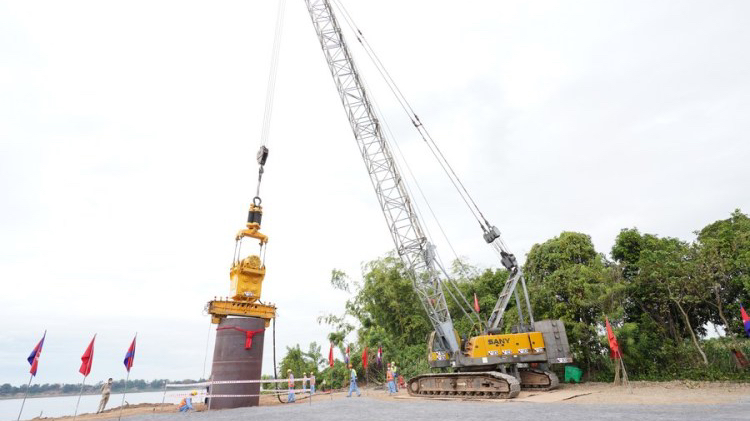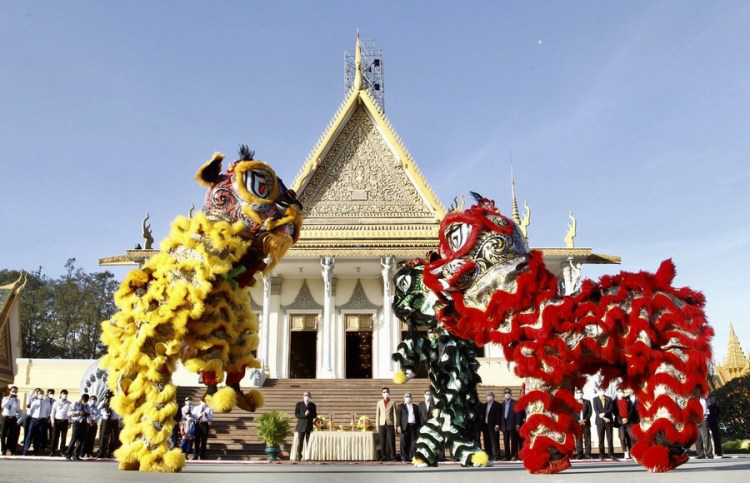
The construction site of a China-funded bridge in Kratie province, Cambodia, January 1,2023. /Xinhua
The construction site of a China-funded bridge in Kratie province, Cambodia, January 1,2023. /Xinhua
Editor's note: Kin Phea is Director General of the International Relations Institute of Cambodia, and Chairman of the Technical Committee of Political Science Terminology of the National Council for Khmer Language. The article reflects the author's opinions and not necessarily the views of CGTN.
Cambodian Prime Minister Hun Sen's three-day visit to China, from February 9 to February 11, concluded with significant and substantial outcomes. The visit builds on the already existing momentum to advance opportunities for both governments to further elevate Sino-Cambodian relations. The two sides reaffirmed their support for each other in all circumstances and formed a consensus on many regional and global issues of common interest for the two countries and peoples.
The announced launch of the "China-Cambodia Friendship Year," which celebrates the 65th anniversary of the establishment of diplomatic relations, ushered in a new era of building a high-quality, high-level, and high-standard China-Cambodia community with a shared future, to carry forward the most treasured ironclad friendship through coming generations.
Official diplomatic relations were established on July 19, 1958; however, Sino-Cambodian relations date back to at least the 13th century. As traditionally close neighbors and partners, China and Cambodia have forged and nurtured an unbreakable "iron-clad" friendship that has weathered various historic tests and difficulties.
According to the joint statement between China and Cambodia, released at the conclusion of Prime Minister Hun Sen's visit, 12 cooperation agreements were signed in the field of foreign affairs. Significantly, both sides agreed to develop a "diamond cooperation framework" with six priority areas, including political cooperation, production capacity and quality, agriculture, energy, security and people-to-people exchanges.
The new diamond hexagon cooperation and already healthy relationship between China and Cambodia carry bright prospects and great optimism for Cambodia, as economic recovery continues and resilience is strengthened. The six priority areas flawlessly reflect the timely and actual needs of Cambodia.
As a post-conflict country, Cambodia has attached great importance to prioritizing peace and stability both domestically and regionally, building prosperity and development, and adhering to the principle of non-interference in its relations with other countries. China is a great power that always supports the Cambodian people's independent choice of their development path best suited to their national conditions, supports Cambodia in defending national sovereignty and security, advancing its major domestic political agenda and economic and social development, and opposes external interference in Cambodia's internal affairs.
Within the comprehensive strategic partnership, an early conclusion of the "New Action Plan of Building a China-Cambodia Community with a Shared Future" is both important and necessary to provide additional momentum to practical cooperation in various fields.
China's vision for global development and ever-closer relations with Cambodia is seen in its track record of investment. China's early and extensive investments in infrastructure, energy and resource development helped spur Cambodia's transition from a Least-Developed Country (LDC) to a Lower Middle-Income Country (LMIC).

Artists perform lion dance at the Royal Palace in Phnom Penh, Cambodia, January 21, 2023. /Xinhua
Artists perform lion dance at the Royal Palace in Phnom Penh, Cambodia, January 21, 2023. /Xinhua
According to the Council for the Development of Cambodia, China's investments in Cambodia constituted almost 22 percent of the Kingdom's total FDI between 1994 and 2019. By 2017, Cambodia had received about $4.2 billion in Chinese development assistance, mostly in the form of grants and soft loans; and, in 2021, China topped the FDI list with a total investment of $2.32 billion, up 67 percent year-on-year.
Sihanoukville is Cambodia's vital coastal economic corridor with vast potential for industry, trade and logistics, tourism and entertainment, and as a fin-tech hub. It is crucial that China sustains its commitment to further development of an "Industrial and Technological Corridor" and that the two countries jointly realize the vision of developing Preah Sihanouk Province as a model multipurpose Special Economic Zone (SEZ). Coupled with the Sihanoukville Special Economic Zone (SSEZ) and Phnom Penh-Sihanoukville Expressway, development of an Industrial and Technological Corridor would attract greater numbers of competent Chinese enterprises to increase investment in Cambodia and explore deeper cooperation in transport facilities, power grids, fiber optic networks and warehousing and logistics to optimize the mix of China-Cambodia production capacity cooperation.
Invigorated by the Regional Comprehensive Economic Partnership (RCEP) and China-Cambodia Free Trade Agreement (CCFTA), the establishment of a "Fish and Rice Corridor" centred on northwestern Cambodia and the Tonle Sap Lake area, will spur development of modern ecological agriculture. Cambodian agricultural modernization ensures an ever-higher range and quality of Cambodian agricultural products being exported to China. Realizing the enormous potential of China-Cambodia free trade will certainly multiply trade levels by a factor of two or three.
According to the United Nations World Tourism Organization, in 2018, Cambodia was the eighth largest recipient of Chinese tourists. In 2019, the number of Chinese tourists was over 2.4 million, or 36 percent of the total. Chinese tourists have greatly contributed to socio-economic development and poverty reduction in Cambodia.
With China's efforts to optimize and adjust its COVID-19 prevention and control policy in light of the evolving situation and the Cambodia-China ironclad friendship, Cambodia is highly optimistic about the large number of future Chinese tourist arrivals in the Kingdom. China is the world's largest tourism source market, and the revival of two-way travel will provide economic and cultural vigor for Cambodia, ASEAN and the rest of the world.
The healthy and stable relationship between China and Cambodia is indicated by extensive and frequent exchange programs, conducted between government officials, business leaders, academics, and people from various walks of life, that all receive generous funding support from the Chinese government.
Prime Minister Hun Sen's visit and the Year of China-Cambodia Friendship provide a solid foundation and great opportunity to expand win-win cooperation at sub-national levels, increase people-to-people and cultural exchanges, strengthen youth exchanges, and carry forward the cause of China-Cambodia friendship.
In the new era of diamond hexagon cooperation, the mutual and strongly held belief that relations between both countries shall continue to grow stronger and diversify into all areas of common interest, shines more brightly. Solidarity in addressing pressing international challenges, solid experience in bilateral dialogue, acceleration of all-level contacts on different platforms, deeply-rooted mutual understanding and respectful approach undeniably guide the two iron-brothers toward greater achievements. The new China-Cambodia diamond cooperation framework illuminates the path and generates a multifaceted momentum for jointly building a community for a shared future.
(If you want to contribute and have specific expertise, please contact us at opinions@cgtn.com. Follow @thouse_opinions on Twitter to discover the latest commentaries in the CGTN Opinion Section.)